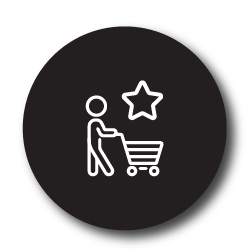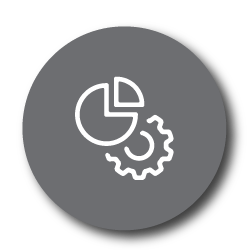Segmenting your consumers based on dynamic purchasing behaviour involves effective behavioural clustering that you can use to understand and target your shoppers more effectively. You can also collect, analyse and use consumer behaviour data as inputs for any cluster analysis exercise that you complete.
Once analysed and profiled, you can leverage these insights to create a personalised assortment plan per cluster.
Other benefits include an improvement in customer satisfaction and increased loyalty. And that’s only the beginning when it comes to why consumer behaviour is so critical to your retail efforts, clustering included.

Why is consumer behaviour important for industry role players to understand?
Consumer behaviour involves the study of consumers and the process that they follow to make a purchase and consumption decision. Consumer behaviour can also be analysed in terms of consumer decision-making and the process that this involves.
Habitual decisions are typically low-involvement decisions that are made often with little implications for the consumer. This may be relevant to everyday, low-cost purchase decisions such as staple groceries. Meanwhile, complex decisions are typically high-involvement decisions that are often made with more significant implications for the consumer. This may be relevant to infrequent, expensive purchases decisions like a car or a laptop.
No matter if you’re a retailer, manufacturer or supplier, if you want to be successful, you need to understand your consumers and their decision-making processes when purchasing products.
Once you have an understanding of who your shoppers are and what, why, how and when they buy from you, you should have an understanding of their purchasing behaviour. This understanding should be on your radar for some of the following reasons:
Consumer segmentation
You can segment your consumers on any basis. Typically, segmentation criteria may be demographics, needs and wants or purchasing patterns and behaviours. Once you have segmented your market, you can analyse and profile the consumer groups. This creates a buyer persona for each segment and provides an in-depth understanding of how to target them.
Consumer value and retention
Analysing your defined segments will provide an indication of customer value to your company and allow you to prioritise groups that are more likely to yield a profitable return and become loyal to your brand.
By understanding what makes your customers tick, you can ensure that your store offers the right mix of products at the right place, price and time. You achieve that by using effective strategies that boosts basket size, average spend as well as satisfaction and loyalty.
New product development and innovation
If you’re a manufacturer or supplier, consumer behaviour is important to monitor because this helps you to identify consumer preferences and possible gaps in the market. On the other hand, if you’re a retailer or third-party category management provider, you need to consider consumer behaviour to influence buying decisions and attitudes. That’s especially if you want to remain relevant.
Utilising consumer behaviour in clustering also assists with predicting consumer acceptance of new innovations. If consumers from one store within a cluster enjoy a particular product, consumers from another store within the same cluster are likely to as well.
Marketing success
Understanding consumer behaviour will allow you to create buyer personas per market segment that you can target through strategic marketing. You can also tailor the marketing method, mix and message to each group for the optimal chance of success.
For example, different consumer groups may respond to certain promotional tactics differently. As an industry role player, it is important to identify and understand the buyer persona you are targeting and use the most effective methods to encourage a purchase.

How is consumer behaviour data collected and analysed?
Data on your shoppers can be collected in various formats that you can use individually or in combination with one another.
Collecting consumer behaviour data
1. POS data
Point of sale data is referred to as POS data. You can collect this data at your till points where transactions occur. Some examples of POS data include:
- Performance data such as sales, units and gross profit as well as selling price per product; and
- Store level data such as store code, name, geographic location and format.
2. Loyalty data
Loyalty data is collected from your customers when they use their loyalty card at a point of sale. This data allows you to collect demographic and purchase information about your consumers. Some examples of loyalty data include:
- Demographics: age, gender, income, marital status, address etc.;
- Purchase frequency: how often the consumer makes a purchase each month;
- Purchase time: what time the consumer makes a purchase each month;
- Basket size: the average number of products purchased per trip each month;
- Basket composition: the products purchased together per trip each month;
- Method of purchase: the platform used to make a purchase (e.g. online/ in-store); and
- Brand loyalty: whether the consumer purchases one or multiple brands for a particular product category.
3. AI-generated data sources
Newer methods of customer data collection are beginning to take shape within the retail industry. Examples include artificial intelligence and machine learning. You can use both to collect and process information into a usable format that you can leverage to understand your consumers.
Some examples of AI-generated data sources may include:
- Facial recognition: in-store scanners may be used to recognise a particular buyer or a buyer profile that enters the store. You can use this information to show targeted ads, targeted product offerings or to analyse the consumer’s in-store behaviour;
- Dwell times: the amount of time spent looking at a product / category or in an aisle; and
- In-store movement trackers: In-store scanners may be used to track the path a shopper takes from entering to leaving the store. You can use this information for optimised floor planning and consumer profiling.
Analysing consumer behaviour data
Consumer behaviour analysis involves a qualitative and quantitative approach. This provides your company with insights into how different attributes (e.g. product, retailer and consumer attributes) influence your target market when making a purchase decision.
The following steps indicate some ways that consumer behaviour can be analysed and leveraged in your business.
1. Segment your market
You can segment your target market using a cluster analysis. DotActiv’s cluster optimiser tool receives segmenting criteria that you select and groups your stores accordingly for a particular category based on similar consumer behaviour.
2. Assess quantitative data by analysing and profiling each cluster
DotActiv’s cluster optimiser tool allows you to analyse your clusters based on a wide range of variables. You can understand cluster composition, cluster differentiation, cluster performance at all levels of the consumer decision tree as well as conduct cluster profiling based on consumer spend.
This helps you to identify driving factors per cluster such as brand preference that can be utilised during assortment planning to target each group effectively.
3. Supplement with qualitative data
If you are a retailer, qualitative data may be provided by other industry roleplayers such as suppliers and manufacturers. External market insights may also be useful here to understand the consumers in each cluster in more detail based on in-depth industry knowledge.
4. Apply these insights to strategic plans
Applying this information takes action in the form of a targeted assortment plan per cluster. Each assortment plan must be targeted to the preferences of each cluster to be successful. This information is also considered during space planning and implementation of these plans in store.
5. Analyse the results
At DotActiv, a proprietary process is followed with a series of meetings and deliverables. The last output involves a post-implementation analysis of any completed work. The results of the cluster, assortment and space plan implementation are assessed to determine the value that was derived from the category management process.

How does DotActiv incorporate consumer behaviour into its industry best-practice software and service offering?
Consumers have dynamic needs and wants. If you segment or group them, this will help you to understand their behaviour and to target them effectively using category management. You can use clustering to input information about your target market and group them accordingly across your various store branches. The more data you collect on your customers, the more accurate your clustering efforts will be.
When clustering your stores, DotActiv aims to group similar stores together based on the consumer behaviour of your shopper base. This is done by using data sources linked to this behaviour as inputs for the cluster analysis.
For example, if you wanted to group your stores according to consumers who purchased similar combinations of products, similar brands and shopped at similar times in the day, you would be likely to use inputs such as basket composition, brand loyalty, shopping time as well as POS performance data for these products. A DotActiv cluster and assortment planner will typically guide you through this process and make recommendations to ensure you choose the right inputs to meet your business’ goals.
Clustering at DotActiv is developed using an industry best-practice innovation methodology. This involves three levels of clustering software and service innovation. Currently, we have access to POS data sources that are used to cluster stores and yield profitable results. DotActiv is currently in the process of incorporating loyalty and external market data sources into our cluster optimiser tool found in DotActiv Enterprise.
Conclusion
Behavioural clustering takes the industry standards of clustering to the next level and allows you to target consumers effectively with a customer-centric approach. This provides value to both the industry role-player and the consumer. DotActiv is on the forefront of this development by growing this division and investing in cutting edge innovation.
Need assistance with clustering? Let DotActiv help. Find out more about our clustering services here or book a free exploratory meeting with a DotActiv expert.


